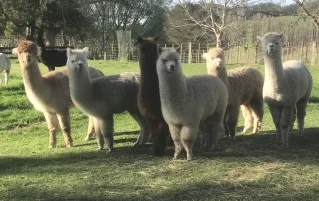
Farm Tours
We offer farm tours for smaller groups and families to meet, feed, interact with and walk with our alpacas.
For full details and to book your experience of these wonderful animals, please go to our reservation form.
The alpaca (Vicugna pacos) is a domesticated member of the camelid family (Camelidae) which also includes camels, llamas, guanacos, and vicuñas.
Their evolution started during the Eocene Period (56 to 33.9 million years ago) when a forest-dwelling rabbit-sized ancestor (Protylopus) first appeared in the subtropical forests of North America. By 35 million years ago, a goat-sized intermediate form (Poebrotherium) had evolved which then diversified into more than 20 genera [1]. The largest of these was Titanotylopus which stood an average height of 3.5 metres at the withers, weighed around 2500kg and like the modern camels, had a hump for fat storage.
At least one genus, including Hemiauchenia, spread southwards to reach South America (during the Great American Biotic Interchange) whilst others traveled across the Bering Strait to reach Eurasia. As a result, the guanaco (Lama guanicoe) and vicuña (Vicugna vicugna) are found in South America whereas the three species of camel (Dromedary, Bactrian and wild Bactrian) are now found in Africa and Asia. In South America, The split between the genera Lama and Vicugna is believed to have occurred between 2 and 3 million years ago.
North American camelids became extinct around 12,000 years ago. Human migration from Asia is likely responsible for their extermination due to over-hunting although climate change may have also contributed.
The alpaca is the domesticated form of the vicuña, selectively bred by Inca peoples between 6,000 and 7,000 years ago in the high-altitude regions of the Peruvian and Bolivian Andes [52]. These animals were highly prized by Andean civilizations, not only for their exceptionally fine fibre, regarded as a luxury reserved for royalty, but also as a reliable source of meat, dung (for fuel), and hides.
Due to interbreeding between the the guanaco and vicuña and later decimation of their numbers by the Spanish conquistadores, it was widely assumed that both llamas and alpacas were domesticated from the guanaco. This was due to their similar morphological characteristics and the disruption caused by Spanish colonization, which led to widespread interbreeding and a sharp decline in camelid populations. However, genetic analysis [11] demonstrated conclusively that the alpaca is descended from the vicuña and not the guanaco.
A very recent and comprehensive whole-genome sequencing study [25] confirmed this ancestry. By analyzing the genomes of llamas, alpacas, guanacos and vicuñas, the research uncovered significant levels of genetic introgression (the transfer of genetic material across species via hybridization followed by backcrossing). Remarkably, the alpaca genome contains 36% introgressed guanaco DNA, whereas the llama genome shows only 5%. This increase in cross-species mixing appears to correlate with the period of the Spanish conquest (1532–1572), a time of massive upheaval in indigenous societies. The collapse of traditional breeding and herd management practices led to uncontrolled interbreeding between domestic and wild camelids.
Following the conquest, the surviving Inca communities took refuge with their alpacas in remote Andean regions such as the Altiplano where the animals were able to survive the harsh, high-altitude conditions. These regions remain as the primary stronghold of alpaca farming, with Peru having around 90% of the global alpaca population.
South American camelids are quite capable of producing viable offspring across species boundaries. For example, crossing a llama and an alpaca produces a Huarizo, a hybrid that tends to have the size and strength of a llama with the fleece characteristics of an alpaca. Similarly, mating an alpaca with a vicuña yields a Paco-vicuña, which more resembles the vicuña. This particular cross is of commercial interest due to its ultra-fine fleece (13–17 microns) and longer staple length, offering a balance between fleece quality and fibre yield that is more sustainable than harvesting pure vicuña wool.
Despite clear differences in size, morphology, and habitat preferences between the Old World camels (the dromedary and Bactrian camels) and the New World camelids (llamas, alpacas, guanacos, and vicuñas), all species share the same diploid chromosome number of 2n = 74. Their chromosomal structures are also highly conserved, supporting the theory of a shared North American ancestor and the close genetic relationships within the Camelidae family, even after millions of years of divergent evolution.
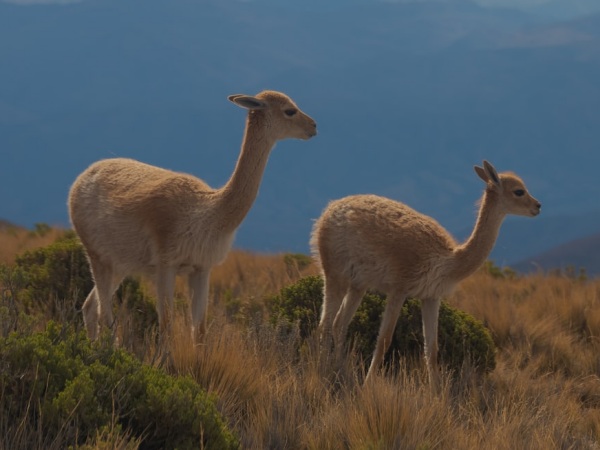
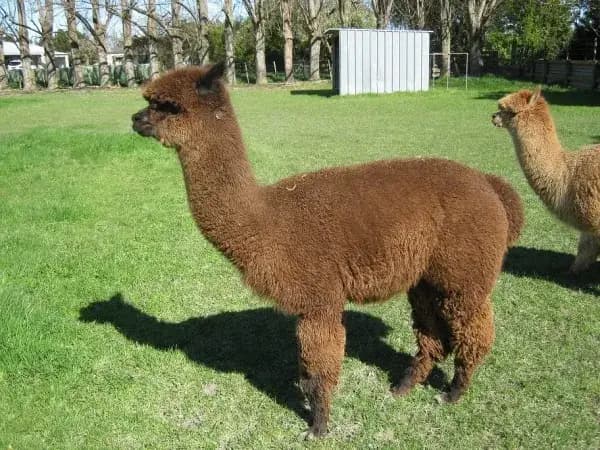
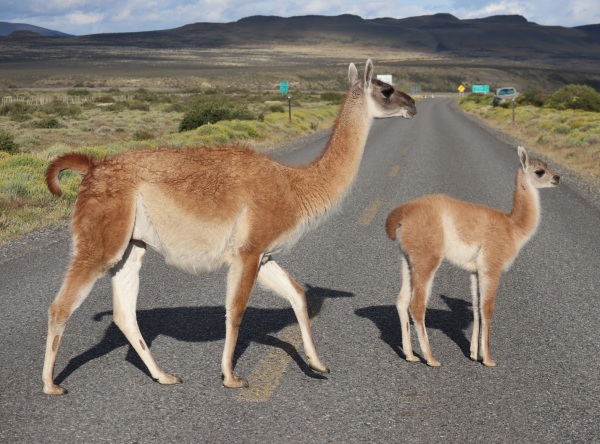
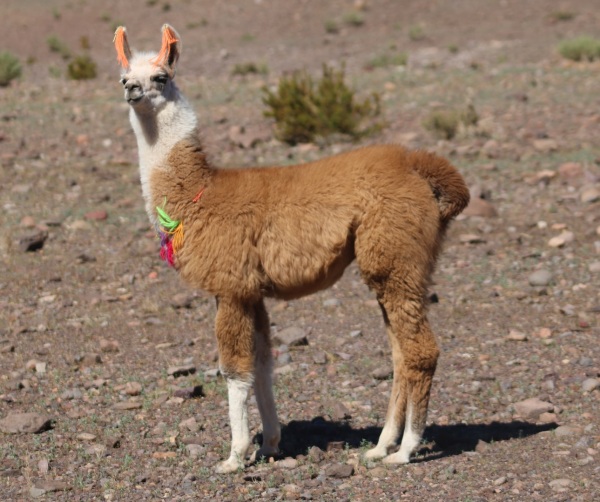
| Class | Mammalia |
| Order | Artiodactyla |
| Family | Camelidae |
| Genus | Lama |
| Species | L. vicugna (Vicuña) L. pacos (Alpaca) L. guanicoe (Guanaco) L. glama (Llama) |
There are two distinct varieties of alpaca, huacaya and suri. Huacaya alpacas make up over 90% of the global population and are by far the most recognisable type. Their dense, crimped hair grows perpendicular to the body to produce the rounded 'teddy bear' appearance. Suri alpacas have smoother, finer fibres that fall parallel to the body in long well-defined locks. It lacks the crimp of Huacaya fibre, resulting in a smoother texture and a natural sheen.
Although the complete DNA sequence of the alpaca genome is now known and chromosome mapping [10] for gene locations underway, no definitive gene or mutation has yet been identified to explain the variation in fleece type. However, based on results from controlled breeding experiments, researchers have proposed a two-gene model to explain the inheritance of Suri and Huacaya traits [13]. In this model, two unidentified but likely linked genes interact to determine fleece type.
The evidence suggests that the suri trait is recessive and so the suri associated variant must be inherited from both parents to express the suri phenotype. All other combinations of traits will result in the offspring having a huacaya fleece. This model explains why two huacaya parents can sometimes produce a suri cria, if both carry the suri gene. Unraveling the genetic elements involved will help breeders more predictably manage fibre quality.
Many photographs of huacaya alpacas can be seen on our Gallery page.
Most of the literature below can be accessed by clicking on the highlighted link. Some links will access the appropriate web page from which the article can be downloaded, but others will immediately start downloading the full reference.
1. Rybczynski, N., Gosse, J.C., Harington, C.R., Wogelius, R.A., Hidy, A.J., and Buckley, M. (2013). Mid-Pliocene warm-period deposits in the High Arctic yield insight into camel evolution. Nature Comm. (4), Article no. 1550.
10. Avila, F., Baily, M. P., Perelman, P., Das, P. J., Pontius, J., Chowdhary, R., Owens, E., Johnson, W. E., Merriwether, D. A. and Raudsepp, T. (2014). A comprehensive whole-genome integrated cytogenetic map for the alpaca (Vicugna pacos). Cytogenet. Genome Res., 144(3): 196-207.
11. Kadwell, M., Fernandez, M., Stanley, H. F., Baldi, R., Wheeler, J. C., Rosadio, R., and Bruford, M. W. (2001). Genetic analysis reveals the wild ancestors of the llama and the alpaca. Proc. R. Soc. Lond. B. 268: 2575-2584.
13. Presciuttini, S., Valbonesi, A., Apaza, N., Antonini, M., Huanca, T., and Renieri, C. (2010). Fleece variation in alpaca (Vicugna pacos): a two-locus model for the Suri/Huacaya phenotype. BMC Genetics, 11: 70-77
25. Fan, R., Gu, Z., Guang, X., Marín, J.C., Varas, V., González, B.A., Wheeler, J.C., Hu, Y., Li, E., Sun, X., Yang, X., Zhang, C., Gao, W., He, J., Munch, K., Corbett-Detig, R., Barbato, M., Pan, S., Zhan, X., Bruford, M.W., and Dong, C. (2020). Genomic analysis of the domestication and post-Spanish conquest evolution of the llama and alpaca. Genome Biol., 21:159-185. https://doi.org/10.1186/s13059-020-02080-6.
52. Yacobaccio, H.D. (2021). The domestication of South American camelids: a review. Animal Frontiers, 11(3): 43-51.